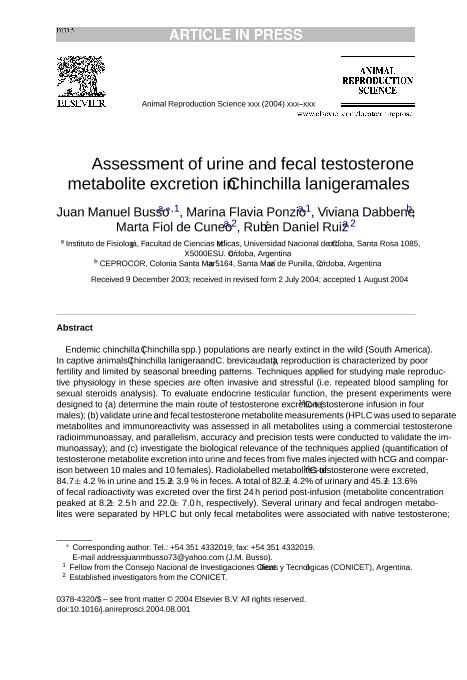Mostrar el registro sencillo del ítem
dc.contributor.author
Busso, Juan Manuel

dc.contributor.author
Ponzio, Marina Flavia

dc.contributor.author
Dabbene, Viviana
dc.contributor.author
Fiol, Marta Haydee

dc.contributor.author
Ruiz, Ruben Daniel

dc.date.available
2020-10-07T22:44:14Z
dc.date.issued
2005-12
dc.identifier.citation
Busso, Juan Manuel; Ponzio, Marina Flavia; Dabbene, Viviana; Fiol, Marta Haydee; Ruiz, Ruben Daniel; Assessment of urine and fecal testosterone metabolite excretion in Chinchilla lanigera males; Elsevier Science; Animal Reproduction Science; 86; 3-4; 12-2005; 339-351
dc.identifier.issn
0378-4320
dc.identifier.uri
http://hdl.handle.net/11336/115568
dc.description.abstract
Endemic chinchilla (Chinchilla spp.) populations are nearly extinct in the wild (South America). In captive animals (Chinchilla lanigera and C. brevicaudata), reproduction is characterized by poor fertility and limited by seasonal breeding patterns. Techniques applied for studying male reproductive physiology in these species are often invasive and stressful (i.e. repeated blood sampling for sexual steroids analysis). To evaluate endocrine testicular function, the present experiments were designed to (a) determine the main route of testosterone excretion (14C-testosterone infusion in four males); (b) validate urine and fecal testosterone metabolite measurements (HPLC was used to separate metabolites and immunoreactivity was assessed in all metabolites using a commercial testosterone radioimmunoassay, and parallelism, accuracy and precision tests were conducted to validate the immunoassay); and (c) investigate the biological relevance of the techniques applied (quantification of testosterone metabolite excretion into urine and feces from five males injected with hCG and comparison between 10 males and 10 females). Radiolabelled metabolites of 14C-testosterone were excreted, 84.7 ± 4.2 % in urine and 15.2 ± 3.9 % in feces. A total of 82.7 ± 4.2% of urinary and 45.7 ± 13.6% of fecal radioactivity was excreted over the first 24 h period post-infusion (metabolite concentration peaked at 8.2 ± 2.5 h and 22.0 ± 7.0 h, respectively). Several urinary and fecal androgen metabolites were separated by HPLC but only fecal metabolites were associated with native testosterone; however, there was immunoreactivity in more than one metabolite derived from 14C-testosterone. After hCG administration, an increase in androgen metabolite excretion was observed (p < 0.05). Males excreted greater amounts daily of urinary androgen metabolites as compared with females (p < 0.05); this difference was not evident in feces. Results of the present study indicate that the procedure used is a reliable and non-invasive method to repeatedly monitor variations in testicular endocrine activity in this species. It can be a useful tool that would help ensure the survival of the wild populations as well as to provide the basis for a more efficient use by the fur industry.
dc.format
application/pdf
dc.language.iso
eng
dc.publisher
Elsevier Science

dc.rights
info:eu-repo/semantics/openAccess
dc.rights.uri
https://creativecommons.org/licenses/by-nc-sa/2.5/ar/
dc.subject
CHINCHILLA - TESTOSTERONE
dc.subject
NON-INVASIVE TECHNIQUES
dc.subject
URINARY AND FECAL ANDROGEN METABOLITES
dc.subject.classification
Zoología, Ornitología, Entomología, Etología

dc.subject.classification
Ciencias Biológicas

dc.subject.classification
CIENCIAS NATURALES Y EXACTAS

dc.title
Assessment of urine and fecal testosterone metabolite excretion in Chinchilla lanigera males
dc.type
info:eu-repo/semantics/article
dc.type
info:ar-repo/semantics/artículo
dc.type
info:eu-repo/semantics/publishedVersion
dc.date.updated
2020-10-06T17:55:37Z
dc.journal.volume
86
dc.journal.number
3-4
dc.journal.pagination
339-351
dc.journal.pais
Países Bajos

dc.journal.ciudad
Amsterdam
dc.description.fil
Fil: Busso, Juan Manuel. Consejo Nacional de Investigaciones Científicas y Técnicas. Centro Científico Tecnológico Conicet - Córdoba. Instituto de Investigaciones Biológicas y Tecnológicas. Universidad Nacional de Córdoba. Facultad de Ciencias Exactas, Físicas y Naturales. Instituto de Investigaciones Biológicas y Tecnológicas; Argentina
dc.description.fil
Fil: Ponzio, Marina Flavia. Consejo Nacional de Investigaciones Científicas y Técnicas. Centro Científico Tecnológico Conicet - Córdoba. Instituto de Investigaciones en Ciencias de la Salud. Universidad Nacional de Córdoba. Instituto de Investigaciones en Ciencias de la Salud; Argentina
dc.description.fil
Fil: Dabbene, Viviana. Provincia de Córdoba. Ministerio de Ciencia y Técnica. Centro de Excelencia en Productos y Procesos de Córdoba; Argentina
dc.description.fil
Fil: Fiol, Marta Haydee. Consejo Nacional de Investigaciones Científicas y Técnicas. Centro Científico Tecnológico Conicet - Córdoba. Instituto de Investigaciones en Ciencias de la Salud. Universidad Nacional de Córdoba. Instituto de Investigaciones en Ciencias de la Salud; Argentina
dc.description.fil
Fil: Ruiz, Ruben Daniel. Consejo Nacional de Investigaciones Científicas y Técnicas. Centro Científico Tecnológico Conicet - Córdoba. Instituto de Investigaciones en Ciencias de la Salud. Universidad Nacional de Córdoba. Instituto de Investigaciones en Ciencias de la Salud; Argentina
dc.journal.title
Animal Reproduction Science

dc.relation.alternativeid
info:eu-repo/semantics/altIdentifier/url/https://www.sciencedirect.com/science/article/abs/pii/S0378432004002015
dc.relation.alternativeid
info:eu-repo/semantics/altIdentifier/doi/https://doi.org/10.1016/j.anireprosci.2004.08.001
Archivos asociados
